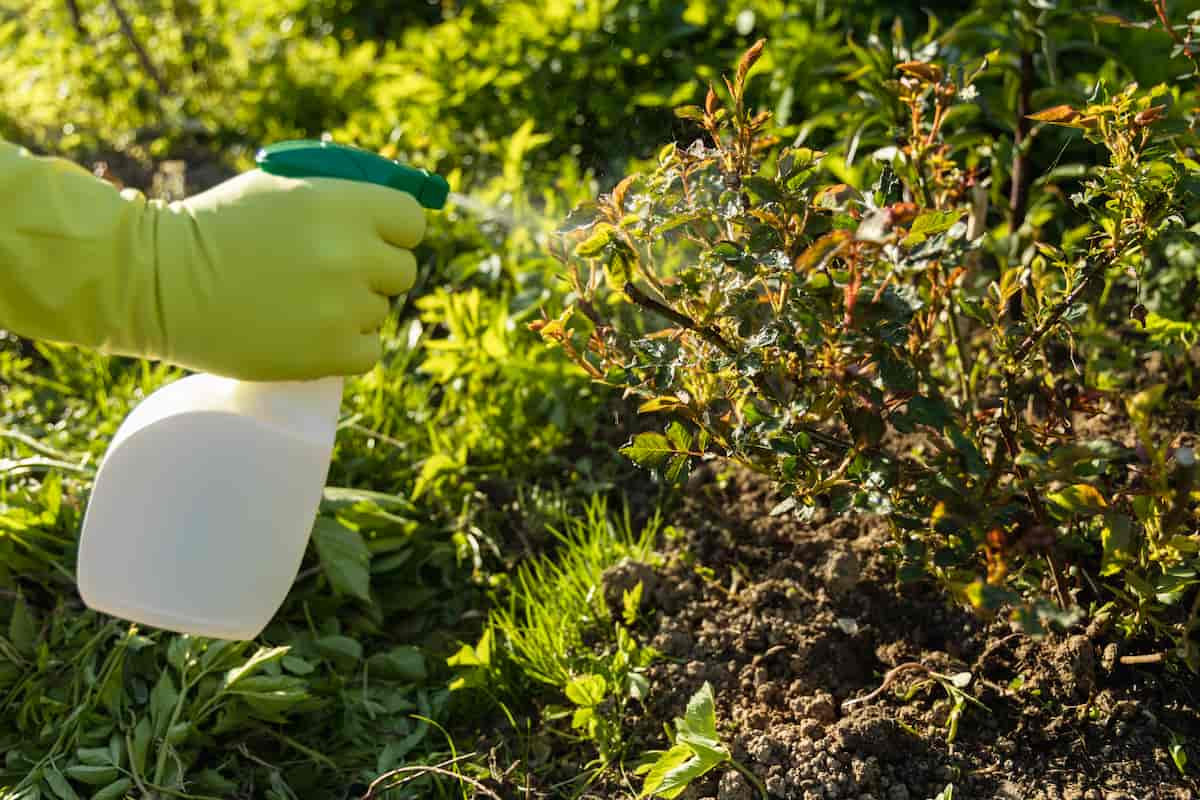The Rose Termite, Odontotermes obesus, belonging to the Family Termitidae of the Order Blattodea, is a highly destructive pest that causes significant yield losses and reduces the quality of crops worldwide. They are commonly known as White ants. Rose crops are particularly vulnerable to the destructive nature of the Rose Termite Pest. It is a destructive pest because it can reproduce and establish large populations quickly, making it difficult to control the pest.

Effective management strategies are essential to minimize the impact of this pest on rose production. To effectively manage this pest, it is necessary to understand its life cycle, its preferred habitats, and the best methods for controlling it. This article will provide an overview and discussion of the Rose Termite Pest in Rose crops, including its symptoms, identification techniques, and control.
Rose Termite Pest Management
Life Cycle of Termite Pest in Rose Crop
The life cycle of the Rose Termite pest has six stages. They are egg, nymph, worker, soldier, alate, and queen. The lifecycle of the Rose Termite begins when the female lays eggs in the soil or a protected area near the food source. The eggs hatch after 14 to 21 days, depending on the temperature and humidity levels. The hatched eggs give rise to nymphs, which go through several stages, shedding their skin each time they molt. During the nymph stage, the termites remain underground and feed on the roots of the rose plant.
As the nymphs continue to develop, they reach the worker stage. The worker’s caste is the most numerous and is responsible for feeding the colony and building the nest. They also carry out the maintenance and cleaning of the nest. Some of the workers develop into soldiers, larger and stronger than the workers. They use large, strong mandibles to defend the colony against predators.
After a few months, the colony produces alates, reproductive termites. They leave the colony and fly out, searching for a mate and a suitable location to start a new colony. If the alates successfully mate and find a suitable location, they shed their wings and act as the queen and king of a new colony. The queen is the largest one in the colony and is responsible for laying eggs. It can lay up to 10,000 eggs in a day.
Occurrence of Termite Pest in Rose Crop
- Location of Rose Termite Pest: This pest infests Rose crops in India, Africa, Sri Lanka, China, Thailand, Vietnam, Indonesia, the United States, Mexico, Brazil, Colombia, Ecuador, the Philippines, and Australia.
- Host Range: The Rose Termite pest infects crops like Rose, Sugarcane, Tea, Cotton, Maize, Banana, and Coconut.
Factors Favoring the Population Increase of Termite Pest in Rose Crop
- Climate – The pest thrives in warm and humid weather conditions as they can reproduce rapidly and develop large colonies.
- Poor Soil Quality – The termites can survive in soils that are low in nutrients and have poor drainage.
- Overcrowding – Pests can easily spread from one plant to another, leading to widespread infestations.
- Poor Management Practices – Poor plant management practices, such as using contaminated tools and improper sanitation, can lead to termite infestation.
Identification of Termite Pest in Rose Crop
- Egg: The eggs are small, white, and oval-shaped, laid in clusters.
- Nymph: The nymphs are small, white, and soft-bodied.
- Adult: The adults have wings and are dark brown or black.
In case you missed it: Rose Flower Chaffer Beetle Pest Management: Symptoms, Treatment, Chemical, Biological, and Organic Control

Damage Symptoms of Termite Pest in Rose Crop
- The adult termites feed on the plant tissues, causing extensive damage to the stems, leaves, and flowers.
- The nymphs feed on the roots of both the young and adult rose plants and cause critical damage to the roots.
- As a result, the growth and development of the rose plant are severely affected, leading to withering, stunted growth, reduced yield, and death.
Percentage of Yield Loss in Roses Due to Termite Pest
- In India, the yield losses due to Rose Termite pests are 50%. In Thailand, the percentage of yield loss is 50%. In Vietnam, the losses are 40%. In Sri Lanka, the losses are 30%. In Indonesia, the losses are 50%. In Africa, it is 80%. In the United States, it is 5-10%. In Mexico, it is 30%. In Brazil, it is 10%. In China, it is 60%.
- In Colombia, the losses are 40%. In Ecuador, it is 20%. In Australia, it is 10%. In the Philippines, the yield losses are 50%. The Economic Threshold Level (ETL) for the Rose Termite pest is set at 10-15% crop infestation.
Termite Pest Management in Rose by Cultural Control
- Mulching – Organic mulches, such as leaves or straw, can help maintain soil moisture, improve soil fertility, and reduce stress on rose plants.
- Sanitation – Remove and destroy infested plant material and debris, and maintain a clean and weed-free growing area.
- Pruning – Proper pruning practices can help to promote healthy plant growth and reduce stress on the rose plants.
- Companion Planting – Plant crops like marigolds or garlic that repel or deter the termites.
Termite Pest Management in Rose by Biological Control
- Predators – Predators like ants, beetles, praying mantises, birds, and lizards feed on adult termites.
- Parasitoids – Parasitic wasps and flies lay their eggs inside the bodies of termite pests.
- Entomopathogenic Fungi – Entomopathogenic fungi, such as Beauveria bassiana and Metarhizium anisopliae, infect and kill the termites.
- Entomopathogenic Nematodes – Entomopathogenic nematodes, such as Steinernema carpocapsae and Heterorhabditis bacteriophora, infect and kill the nymphs in the soil.
Termite Pest Management in Rose by Chemical Control
- Spray Insecticides on the crops like Carbaryl, Malathion, Methyl Parathion, Chlorpyriphos, Dimethoate, Cypermethrin, Permethrin, Deltamethrin, Imidacloprid, and Thiamethoxam on the foliage to control the termites in rose crops.
- Soil Incorporation – Mix Lindane or Carbaryl dust powder with the soil to control the nymphs in the ground.
- Soil Drenching – Drench the soil with Chlorpyriphos or Lindane to control the termites.
- Fumigation – Treat the soil with Carbaryl or Methyl Bromide to control the nymphs in the ground.
Termite Pest Management in Rose by Organic Control
- Plant extracts from neem, garlic, cinnamon, ginger, turmeric, hot pepper, and tobacco can be applied to manage the infestation.
- Bacillus thuringiensis-based bio-insecticides produce toxins that can kill the termites.
- Pyrethrum, obtained from chrysanthemum, contains neurotoxins that paralyze and kill the pest.
- Adding compost, manure, and other organic amendments to the soil can help improve soil health and reduce pest populations.
Preventive Control Measures of Rose Termite Pest
- Soil Management – Good soil management practices like regular soil cultivation and drainage can prevent termite infestation.
- Physical Barriers – Place barriers like mesh screens, plastic sheets, and metal foils around the base of plants to prevent termites from burrowing into the soil.
- Regular Monitoring – Monitor the crops regularly to identify pest infestation in the early stages to keep it under control.
- Sticky Traps – Use yellow sticky traps to monitor the pest’s activity and determine the control measures.
In case you missed it: Rose Leaf Cutter Bee Pest Management: Symptoms, Treatment, Chemical, Biological, and Organic Control

Conclusion
The Rose Termite Pest, Odontotermes obesus, is a destructive pest that affects Rose crops worldwide, causing significant yield losses. By implementing Integrated Pest Management strategies that combine multiple control methods, farmers can effectively manage the pest and protect their crops.
- Deworming Schedule for Dogs/Puppies: A Beginners Guide
- How to Prevent and Control Parasites in Goats
- Beneficial Insects in Pest Management
- Natural Solutions for Pest Control in Flower Gardens
- Types of Fungicides Used in Agriculture
- Common Issues in the Fruit Development Stage of Pomegranate Farming
- Fruit Development Issues in Papaya: Easy Solutions and Treatment
- Soil-Borne Diseases and How to Protect Your Plants
- Practices to Prevent Disease Spread in the Garden